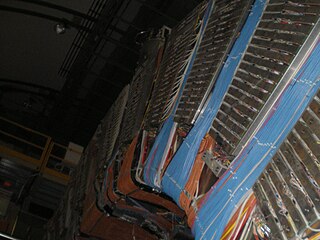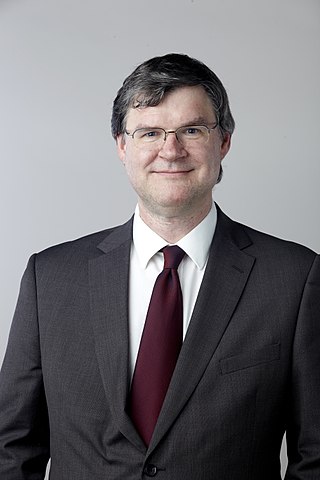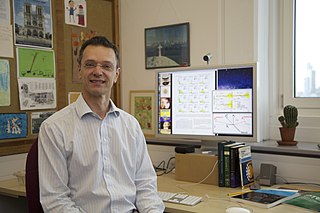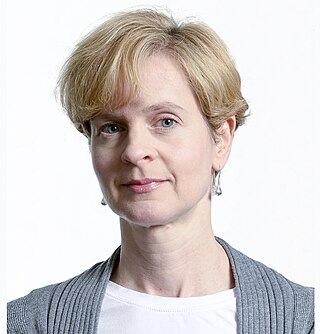
The European Organization for Nuclear Research, known as CERN, is an intergovernmental organization that operates the largest particle physics laboratory in the world. Established in 1954, it is based in a northwestern suburb of Geneva, on the France–Switzerland border. It comprises 23 member states. Israel, admitted in 2013, is the only non-European full member. CERN is an official United Nations General Assembly observer.

The Large Hadron Collider (LHC) is the world's largest and highest-energy particle collider. It was built by the European Organization for Nuclear Research (CERN) between 1998 and 2008 in collaboration with over 10,000 scientists and hundreds of universities and laboratories, as well as more than 100 countries. It lies in a tunnel 27 kilometres (17 mi) in circumference and as deep as 175 metres (574 ft) beneath the France–Switzerland border near Geneva.

The Large Electron–Positron Collider (LEP) was one of the largest particle accelerators ever constructed. It was built at CERN, a multi-national centre for research in nuclear and particle physics near Geneva, Switzerland.

DELPHI was one of the four main detectors of the Large Electron–Positron Collider (LEP) at CERN, one of the largest particle accelerators ever made. Like the other three detectors, it recorded and analyzed the result of the collision between LEP's colliding particle beams.

The DØ experiment was a worldwide collaboration of scientists conducting research on the fundamental nature of matter. DØ was one of two major experiments located at the Tevatron Collider at Fermilab in Batavia, Illinois. The Tevatron was the world's highest-energy accelerator from 1983 until 2009, when its energy was surpassed by the Large Hadron Collider. The DØ experiment stopped taking data in 2011, when the Tevatron shut down, but data analysis is still ongoing. The DØ detector is preserved in Fermilab's DØ Assembly Building as part of a historical exhibit for public tours.
The
B
s meson is a meson composed of a bottom antiquark and a strange quark. Its antiparticle is the
B
s meson, composed of a bottom quark and a strange antiquark.

David George Charlton is Professor of Particle Physics in the School of Physics and Astronomy at the University of Birmingham, UK. From 2013 to 2017, he served as Spokesperson of the ATLAS experiment at the Large Hadron Collider at CERN. Prior to becoming Spokesperson, he was Deputy Spokesperson for four years, and before that Physics Coordinator of ATLAS in the run-up to the start of collision data-taking.

Terence Richard Wyatt is a Professor in the School of Physics and Astronomy at the University of Manchester, UK.

Jonathan Mark Butterworth is a Professor of Physics at University College London (UCL) working on the ATLAS experiment at CERN's Large Hadron Collider (LHC). His popular science book Smashing Physics, which tells the story of the search for the Higgs boson, was published in 2014 and his newspaper column / blog Life and Physics is published by The Guardian.

Wendy Taylor is an Experimental Particle Physicist at York University and a former Canada Research Chair. She is the lead for York University's ATLAS experiment group at CERN.

Valerie Gibson, also known as Val Gibson, is a professor of Physics and Head of the High Energy Physics group at the University of Cambridge.

Ayana Holloway Arce is a Professor of Physics at Duke University. She works on particle physics, using data from the Large Hadron Collider to understand phenomena beyond the Standard Model.

Beate Heinemann is a German particle physicist who has held positions at universities in Europe and the United States. She currently holds a joint appointment at two German institutions, Albert Ludwigs University of Freiburg and the DESY laboratory in Hamburg.

Maria Girone is the Chief Technology Officer (CTO) of the CERN openlab. She leads the development of High Performance Computing (HPC) technologies for particle physics experiments.
Tulika Bose is a Professor of Physics at the University of Wisconsin-Madison, whose research focuses on developing triggers for experimental searches of new phenomena in high energy physics. Bose is a leader within the Compact Muon Solenoid (CMS) experiment, a CERN collaboration famous for its experimental observation of the Higgs boson in 2012.
Sinéad Farrington is a British particle physicist who works on the ATLAS experiment at the Large Hadron Collider.

Bradley Cox is an American physicist, academic and researcher. He is a Professor of Physics and the founder of the High Energy Physics Group at the University of Virginia.

Sheldon Leslie Stone was a distinguished professor of physics at Syracuse University. He is best known for his work in experimental elementary particle physics, the Large Hadron Collider beauty experiment (LHCb), and B decays. He made significant contributions in the areas of data analysis, LHCb detector design and construction, and phenomenology.

Sarah C. Eno is an American experimental particle physicist at the University of Maryland, College Park, where she is a professor of physics and UMD Distinguished Scholar–Teacher. She has participated in several large experimental collaborations in high-energy physics, including the AMY experiment at the Japanese TRISTAN particle accelerator, the DØ experiment at Fermilab in the US, the Collider Detector at Fermilab, and the Compact Muon Solenoid experiment at the Large Hadron Collider in France and Switzerland.

















